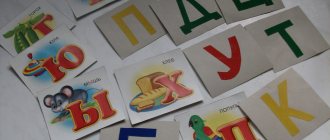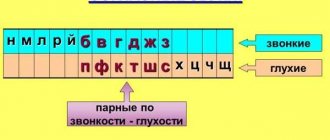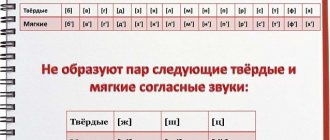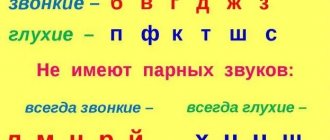School classification
The first classification criterion is: hardness/softness. 18 out of 21 consonants have pairs of hardness and softness, that is, in different words they can be pronounced hard or soft. For example: cow, friend - k, r, v, d, g in these words - solid. However, we can choose other words where they will be soft: rivers, see, whoop - here we already pronounce them softly.
There is no hardness/softness pair for six sounds: w/sh/ts (hard only) and h/y/shch – (soft only). Whatever vowel is after z/sh/ts, they will be solid: life - [zhyz'n'], compass - [tsy'rkul'], sew - [shyt']. Ch/y/sh – always pronounced softly – practice: bangs, brush, iodine, fir-tree [yo'lka], tickle, tea, etc.
On a note. There may be deviations from this rule when it comes to borrowed words. For example, in the word “jury” [zh'] is pronounced softly.
The second criterion is sonority and deafness. Compare the pronunciation of [z] and [s], [d] and [t], [b] and [p], [g] and [k] - what is the difference? In the first case you add a voice to the pronunciation, in the second there is no voice, only noise.
There is no voiced/voiceless pair for sonorant sounds. There are five of them: [p], [l], [m], [n], [th]. They are only voiced. To make it easier to remember sonorants, say them several times in the sequence given above. They are pronounced easily, without hesitation, and remain in memory.
Voiceless unpaired: [x], [ts], [h], [sch]. They cannot have a voiced analogue; in principle, they do not exist.
We looked at the signs that are included in phonetic analysis at school. I’ll take the word “cranberry” as an example so that all the signs are better remembered in your head.
- Emphasis: cran'kva.
- Syllables: klu-kva.
- Characteristic:
- K – [k] – consonant, hard (paired), voiceless (paired).
- L – [l'] – consonant, soft (paired), voiced (unpaired), sonorant.
- Yu - [u] - vowel, stressed.
- K – [k] – consonant, hard (paired), voiceless (paired).
- В – [в] – consonant, hard (paired), voiced (paired).
- A – [a] – vowel, unstressed.
- 6 letters, 6 sounds.
Have questions? Write in the comments, I will answer within 24 hours.
Full phonetic analysis of the word
Phonetic analysis plan:
- Spelling of a word.
- Dividing a word into syllables and stress location.
- Possibility of transfer.
- Phonetic transcription of the word.
- Characteristics of all sounds in order:
- consonant - voiced - voiceless (paired - unpaired), hard - soft (paired - unpaired), which letter is indicated;
- vowel: stressed – unstressed.
- Number of sounds and letters.
- Cases of discrepancy between sound and letter.
Sample parsing
- Buddies
- Syllables: pri-ya-te-li (4 syllables; stress falls on the 2nd syllable).
- Transfer: when-I-those-whether.
- [pr'ijat'l'i]
- p [p] – consonant, voiceless pair, hard pair. р [р'] – consonant, voiced unpaired, soft paired. and [and] – vowel, unstressed. i bracket [j] – consonant, voiced unpaired, soft unpaired. [á] – vowel, stressed. t [t'] – consonant, voiceless pair, soft pair. e [b] – vowel, unstressed. l [l'] – consonant, voiced unpaired, soft paired. and [and] – vowel, unstressed.
- 8 letters – 9 sounds.
- The letter i denotes two sounds – [já].
Thus, speech sounds differ from all other sounds in that they form words. Sound is the smallest basic unit of language, along with words, phrases and sentences. But, unlike them, sound has no semantic meaning.
It is thanks to sounds that we distinguish between the words that we hear and pronounce: house [house] and rum [rum] - the difference is in one sound. Sounds create the sound shell of words and thereby help to distinguish words from each other, i.e. perform a meaning-distinguishing function.
Hard and soft consonants
Consonants are divided into hard and soft, this division is due to the difference in the position of the tongue when pronouncing them. When we pronounce soft consonants, then the middle back of the tongue is raised towards the hard palate. We also note that in addition to the fact that consonants are divided into hard and soft, they can be paired and unpaired.
For example, the letter “k” can denote both a hard sound [k], for example, in the word cat, and a soft sound [k`], for example, in the word glasses. We find that the sounds [k] and [k'] form a hardness-softness pair . For consonant sounds that have a pair of hardness and softness, the following rule applies:
- a consonant sound is hard if it is followed by vowels: a, o, u, s, e;
- and is soft if it is followed by vowels: e, e, i, yu, i.
In the Russian language there are letters in which the sound they denote can only be hard ([ш], [ж], [ц]), or only soft ([й], [ч`], [ш`]). Such sounds do not belong to paired sounds, but are unpaired.
Hard and soft consonants
Distinctive features of soft and hard sounds
- When a consonant is followed by the letters a, o, u, s, e , then we can definitely say: this consonant is hard. Let's check: house, garden, goose, cheese, rap. Here the first sounds in the words [d], [s], [g], [s], [r] are hard.
If two consonants are in a row, then the first one will give hardness. Let's check: shift - [sm'ena]. The hard sign ъ is an indicator of the hardness of a consonant: [congress], [entrance].
- When a consonant is followed by the letters e, e, i, yu, i , then we can definitely say: this consonant is soft. Let's check: lion, flax, strength, muesli, ball. Here the first sounds in the word [l'], [l'], [s'], [m'], [m'] are soft.
Also, a soft sign behind a consonant helps the child determine softness. Let's check: [coat], [porch], [teacher]. Note that the soft [l'] in the middle of a word is always denoted in writing by the soft sign ь : [mul'tik], [chair]. For other letters you need to check the dictionary.
Table of signs of hard and soft sounds
| Solid | Soft |
| before a, o, y, s, uh | before e, e, i, yu, i |
| ъ | b |
| before another consonant |
Always soft sounds in Russian
The letters ch, shch, th are always soft, even if they are followed by the vowels a, o, u, y, e: [ch'ash'a].
Always hard sounds in Russian
The letters zh, sh, c are always hard, even if they are followed by the vowels e, e, i, yu, i: [gutter].
Indication of softness of consonants in writing
In Russian, the softness of consonants is indicated in the following ways:
- Using the letter ь (soft sign) at the end of a word and in the middle between consonants: benefit - [pol′za], elk - [los′], etc.
Note. The soft sign does not indicate softness of consonants in the following cases:
a) if it serves to separate consonants, the second of which is y (yot): leaves - fox[t′ya], linen - be[l′yo];
b) to distinguish grammatical categories: rye (3 cl., f.r.) - knife (2 cl., m.r.);
c) to distinguish the forms of words (after hissing ones): read (2 liters, singular), cut (imperative form), help (indefinite form of the verb), as well as adverbs: jump up, lay down.
- Through the letters i, e, e, yu, i, indicating the softness of the preceding consonant sound and conveying the vowel sounds [i], [e], [o], [u], [a]: forest - [l′es], honey - [m'ot], lil - [l'il], hatch - [l'uk], crumpled - [m'al].
- Using subsequent soft consonants: cog - [v′in′t′ik], plum - [s′l′iva].
Voiceless and voiced consonants
Consonants are divided into voiced and unvoiced sounds. In this case, voiceless consonants are pronounced with the mouth practically covered and the vocal cords do not work when pronouncing them. Voiced consonants require more air, and the vocal cords work when pronouncing them. That is, voiced consonants consist of noise and voice, and voiceless consonants consist only of noise.
Lifehack for determining the deafness or voicedness of consonants for schoolchildren
To determine whether a sound you encounter is dull or voiced, and children often have difficulty with this, you should cover your ears with your hands and pronounce the sound. When pronouncing dull sounds, they will be heard somewhere in the distance, but when pronouncing voiced sounds, your ears will actually ring! This way you can determine what sound was encountered. Especially during phonetic analysis of words.
Some consonant sounds are similar both in their sound and also in the way they are pronounced. However, such sounds are pronounced with different tonality, that is, either dull or loud. Such sounds are combined in pairs and form a group of paired consonants. There are 6 such pairs in total, each of them has a voiceless and a voiced consonant sound. The remaining consonants are unpaired.
- paired consonants: b-p, v-f, g-k, d-t, z-s, zh-sh.
- unpaired consonants: l, m, n, r, y, c, x, h, shch.
Publicity of sounds
Vowels are a type of sound during which the air flow through the larynx or nasal cavity is unobstructed. The vocal cords are vibrated by an air stream. At this moment they are tense and shifted.
REFERENCE! Vowels are sometimes called “mouth openers” because they require you to open your mouth wide to pronounce them louder. This distinguishes them from consonants - “mouth-closers”, because in order to make them louder, you need to bring the organs of the mouth as close as possible.
Vowel differentiation is achieved by changing the shape of the resonator. This could be a change in body position or the root of the tongue or lips. In the languages of the world, nasal articulation and phonation are also possible.
Sonorant, noisy, hissing and whistling consonants
In the Russian language, sonorant, noisy, as well as hissing and whistling consonant sounds are also distinguished. We will give a definition of each of the named types of consonants, and also list which consonants belong to one or another type.
Sonorant consonants
Sonorant consonants are voiced unpaired consonants.
There are 9 sonorant sounds in total: [th'], [l], [l'], [m], [m'], [n], [n'], [r], [r'].
Noisy consonants
Noisy consonant sounds are divided into voiced and voiceless. Voiceless noisy consonants include 16 sounds: [k], [k'], [p], [p'], [s], [s'], [t], [t'], [f], [f '], [x], [x'], [ts], [ch'], [sh], [sh'], and noisy voiced consonants include 11 sounds: [b], [b'], [ c], [v'], [g], [g'], [d], [d'], [g], [h], [h'].
Hissing consonants
There are a total of 4 hissing consonant sounds in the Russian language: [zh], [ch'], [sh], [sch']. They all resemble hissing to the ear, which is why they are called hissing consonants.
Sibilant consonants
Whistling consonants
Whistling consonants
Whistling consonant sounds [з] [з'] [с] [с'] [ц] are, in their pronunciation, front-lingual, fricative. When articulating hard sounds [z], [s] and [ts], the teeth are exposed, the tip of the tongue leans against the lower teeth, and the back of the tongue is slightly arched, the lateral edges of the tongue are pressed against the upper molars. The air passes through, creating frictional noise.
When articulating soft sounds [s'] and [z`], the same thing happens, but the back of the tongue rises to the hard palate.
When pronouncing voiced sounds [з] and [з`], the vocal cords are closed and vibrate, but the velum palatine is raised. Other articles on the topic Russian language
Test on the topic
- /10
Question 1 of 10What does phonetics study?
Start test
Hall of Fame
To get here, take the test.
- Galina Aleshkina
10/10
- Yulia Telnova
10/10
- Yana Lebedeva
9/10
- Mark Aliev
9/10
Other types of consonants
There are a few more names that you need to remember to easily understand the rules.
Unpronounceable
Due to the peculiarities of pronunciation in our language, some consonants in words “fall out”: sun - [l], stairs - [t], hello - [v].
To check an unpronounceable sound, you need to choose a single-root word in which there will be a vowel after the dubious consonant or there will be no combination of several consonants. For example, we check “hello” with the word “health”, “sun” - “sunny”, “sun”.
Doubled
This is when two identical consonants are nearby. The most famous example is the double NN rule.
Words that have double consonants in the root are usually borrowed: ammonium, ton, kilogram.
Diphthongs and Triphthongs
Depending on whether the acoustics of a sound changes during its articulation, there are:
- monophthongs,
- diphthongs,
- triphthongs.
Monophthongs are integral and do not break down into elements. Diphthongs and triphthongs, on the contrary, contain transitions from one sound type to another (and a third).
REFERENCE! In turn, they can be descending (the top of the syllable is the first vowel), ascending (the top of the syllable is the last vowel), and ascending-descending triphthongs occupy an intermediate position.
Russian vowels are predominantly monophthongs. Exceptions are iotated sounds corresponding to the letters i, ё, yu, e. However, if they are paired with consonants, they denote a monophthong and only soften the preceding sound.
For example: “I sing” [poy'u] or “yula” [y'ula], where [y'y] is an ascending diphthong; but in the word “love” [l'ubof'] there is no diphthong.
Thus, vowel sounds are represented in the world's languages in all their diversity. Some of their characteristics are inherent in Russian-language speech, others are expressed only as articulatory defects.
Related posts:
- Rhoticism in speech - complete information Rhotacism (problem with the sound [P]) is the most common disorder in children...
- A child does not know how to say R - we’ll show you how to teach it. To teach a child to pronounce the letter R, you need to regularly perform special...
- What do we know about Morse code? Morse code was created to transmit short information. But use...
- Teaching a child to read Teaching reading in preparation for school. When can you teach a child...
Letter and sound Y
The letter Y (and short) means the sound [th']: paradise [paradise'].
The letter Y is written:
- At the beginning of the words: iodine, yogurt.
- In the middle of words, before consonants: Laika, T-shirt, coffee pot.
- At the end of the words: paradise, may, yours.
The sound [th'] is more common than the letter Y, since it appears in words where there is no letter J, but there are vowels Ya, E, Yu and E. Let's consider in what cases the sound [th'] occurs in words that do not contain the letter Y:
- The vowels Ya, E, Yu and Yo are at the beginning of the word: yama [y'ama].
- The vowels I, E, Yu and E come after the vowels: yours [your'o].
- The vowels Ya, E, Yu and Yo come after the dividing hard sign (Ъ): entry [vy'ezd].
- The vowels Ya, E, Yu and Yo come after the soft separating sign (b): pours [l'y'ot].
- The vowel I comes after the soft separating sign (b): beehives [ul'y'i].
Word and phrase stress, intonation
It is necessary in order to divide the speech stream into separate parts, which ultimately helps the listener to understand what the speaker is saying.
Word stress helps to separate different forms of a word and identical words that differ only with its help.
Functional words and interjections do not have their own stress and, in a phonetic sense, are part of the independent word to which they refer.
Phrase stress allows you to highlight the most important word within one statement. With its help, you can interpret exactly the same phrases in different ways.
As for intonation, it allows you to make sentences declarative, interrogative or exclamatory.
How to teach children to distinguish between hard and soft consonants
The child will learn the difference if he is shown it visually or if he is allowed to feel it through experience. For example, Zaitsev’s cubes with soft consonants are small in size, and with hard consonants they are large. The child makes up words and sees this difference every time.
Also, when analyzing words, you can take pictures that remind the child of something soft and something hard. For example, a pillow and a stone. Hearing a soft sound, the child shows a picture of a pillow. Pictures can be attached to cards or drawn next to letters in a notebook.
Phonology
Phonology (from the Greek “sound” and “teaching”) is a branch of linguistics devoted to the study of the structure of the sound structure of a language and the functioning of sounds in the language system.
If we take a vowel sound as a phoneme - a unit of language that does not have independent lexical and grammatical meaning - then its functions are obvious:
- act as the core of a syllable, that is, its obligatory element. In some languages, sonants or obstruents take on this role.
- bear emphasis, that is, highlight words within a word;
- determine tone, that is, use pitch to differentiate meaning within words or morphemes.
WHO STRIKED THE VOWEL?
All six vowel sounds can be in a word in stressed or unstressed positions. Their difference is as follows:
- percussive sounds are pronounced more clearly;
- unstressed ones sound less distinct and can act as another phoneme.
This was mentioned above: the sound [and] can appear in speech where other letters appear in the letter. Compare: milk - [m a l a k o]; serpentine – [s'i r p a n t'i n]; all-terrain vehicle – [in' and z d' and x about t].
A strange story happened - in the word milk, the sound [a] is indicated by the letter o in unstressed syllables, and the sound [i] in writing is expressed by the letter e. In stressed syllables such changes do not occur: milkman - [ma l o ch'n' and k ].
In the word milkman, the sound [o] remains under stress; without stress we hear [a]:
milk – milky ([m a la k o]- [m a l o h' n' and k]).
Unstressed sounds cause many difficulties when writing. How to write correctly - herbal or herbal, in the forest or in the fox? For correct spelling, the definition is very important:
To check the correct spelling of an unstressed vowel, you need to change the word so that it is stressed: in the forest - forest, grassy - grass.
![Sound [Z]](https://lubcentre.ru/wp-content/uploads/zvuk-z-330x140.jpg)






